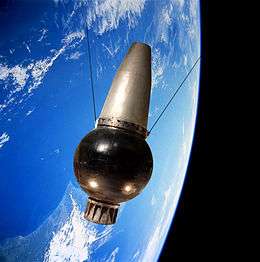Ōsumi (satellite)
 | |
| Mission type | Earth science |
|---|---|
| Operator | Institute of Space and Aeronautical Science, University of Tokyo (now part of JAXA) |
| COSPAR ID | 1970-011A |
| Spacecraft properties | |
| Launch mass | 24.0 kilograms (52.9 lb)[1] |
| Power | 10.3 watt[1] |
| Start of mission | |
| Launch date | February 11, 1970, 04:25 UTC |
| Rocket | Lambda-4S |
| Launch site | Kagoshima LA-L |
| Contractor | ISAS |
| End of mission | |
| Last contact | February 12, 1970[2] |
| Decay date | August 2, 2003[3] |
| Orbital parameters | |
| Reference system | Geocentric |
| Regime | Medium Earth |
| Eccentricity | 0.262379[4] |
| Perigee | 350 kilometres (220 mi) |
| Apogee | 5,140 kilometres (3,190 mi) |
| Inclination | 31.0 degrees[5] |
| Period | 144.0 minutes |
Ōsumi (or Ohsumi) is the name of the first Japanese satellite put into orbit, named after the Ōsumi Province in the southern islands of Japan. It was launched on February 11, 1970 at 04:25 UTC with a Lambda 4S-5 rocket from Uchinoura Space Center by Institute of Space and Aeronautical Science, University of Tokyo, now part of the Japan Aerospace Exploration Agency (JAXA). Japan became the fourth nation after the USSR, United States and France to release an artificial satellite into successful orbit on its own.
See also
References
- 1 2 "Ohsumi". NASA NSSDC Master Catalog. NSSDC, NASA. Retrieved 2008-02-12.
- ↑ "ohsumi". Retrieved 14 August 2015.
- ↑ "SPX-598". SPACEWARN Bulletin. NSSDC, NASA. Retrieved 2008-03-02.
- ↑ "Trajectory Details". NASA NSSDC Master Catalog. NSSDC, NASA. Retrieved 2008-02-12.
- ↑ "Osumi". Encyclopedia Astronautica. Astronautix. Retrieved 2008-03-02.
External links
| Wikimedia Commons has media related to Ohsumi. |
This article is issued from Wikipedia - version of the 5/30/2016. The text is available under the Creative Commons Attribution/Share Alike but additional terms may apply for the media files.